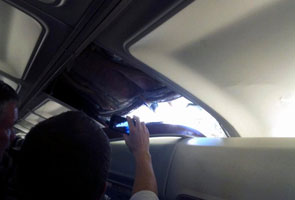
"We're taking them out of service to inspect them over the next few days," Whitney Eichinger, a Southwest spokeswoman, said Saturday. She said they would be "looking for the same type of aircraft skin fatigue."
In a news release, Southwest announced that it would cancel about 300 flights on Saturday because of inspections, and that customers should expect delays of up to two hours.
"The safety of our customers and employees is our primary concern," Mike Van de Ven, Southwest's chief operating officer, said in a statement. "We are working closely with Boeing to conduct these proactive inspections and support the investigation."
The Southwest plane, a 15-year old Boeing 737-300, was cruising at around 35,000 feet on Friday afternoon en route to Sacramento from Phoenix when passengers heard an explosion. The Associated Press reported that one woman described it as "gunshot-like."
Oxygen masks were released, and two people, a passenger and a flight attendant, passed out as the pilot descended to make an emergency landing at a military base in Yuma, Ariz. Nobody was seriously injured, Ms. Eichinger said.
The Federal Bureau of Investigation told The Associated Press that there was no reason to suspect terrorism.
All 118 passengers on board chose to continue on to their destination Friday evening aboard a replacement jet, Ms. Eichinger said.
Southwest Airlines' fleet is made up entirely of Boeing 737s, and the 79 planes the company grounded were all 737-300s.
Pictures of the airplane show that a flap of the aircraft's skin near the overhead baggage compartments was peeled back.
"You can see completely outside," one passenger, Brenda Reese, told The Associated Press. "When you look up through the panel, you can see the sky."
This was not the only incident in American skies on Friday.
In a separate episode, an American Airlines flight from Reagan National Airport in Washington to Chicago made an emergency landing in Dayton, Ohio, after two flight attendants told the captain they were feeling dizzy. Jim Faulkner, a spokesman for American Airlines, said they were investigating whether the plane had depressurized improperly. No other planes had been taken out of service.
And an Atlantic Southeast Airlines flight from Atlanta to Little Rock, Ark., made an emergency landing after hitting a flock of birds. None of the 48 passengers or three crew members on the regional jet were injured, and the plane was operating normally when it landed in Little Rock, said Kate Modolo, a spokeswoman for Atlantic Southeast.
CNN reported that the aircraft sustained substantial visible damage to its nose and that at least one dead crane was stuck to the front when it landed.
Regarding the Southwest incident, James E. Hall, a former chairman of the National Transportation Safety Board, said the company worked its airplanes especially hard, scheduling flights with very quick turnaround times. "They pound their airplanes daily," Mr. Hall said.
Two years ago, Southwest faced a similar episode when a hole ripped open in a plane's fuselage and forced an emergency landing on a flight bound for Baltimore. Earlier that year, Southwest was fined $7.5 million for safety violations by the Federal Aviation Administration.
In 1988, a flight attendant was swept to her death and scores of passengers were injured when an Aloha Airlines Boeing 737 suffered a 20-foot rupture in its fuselage during a flight in Hawaii. The flight, carrying 89 passengers and a crew of five from Hilo to Honolulu, was at 24,000 feet when the tear occurred.
The pilots sent an emergency message to air traffic controllers and then guided the aircraft to a safe landing at the Kahului airport on the island of Maui. The right under-wing engine had been knocked out of commission by debris from the fuselage section that ripped away.
Though one flight attendant was swept from the plane, passengers held on to a second to keep her from being pulled out. Sixty passengers were injured.
Despite Friday's episode, Mr. Hall said, "My experience with Southwest is that they have a good safety program."
He added: "But the skin of the aircraft is like human skin. Any type of puncture is serious."


No comments:
Post a Comment